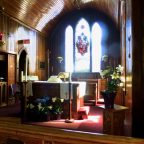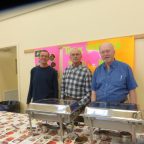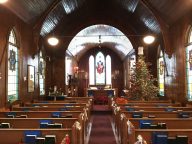Do We See? (October 28, 2018)
Throughout the Bible, seeing is an important metaphor for faith. We trust God and we learn to see more clearly. The more clearly we learn to see, the more deeply we learn to trust God. It’s one of those wonderful paradoxes of faith, what Buddhists call a koan.
The theme runs through our readings this morning. At the end of the story of Job, he says to God that now he sees. “I had heard of you by the hearing of the ear, but now my eye sees you.”
In our Psalm we read, “Look on God … and be radiant. Taste and see … how good the Lord is.”
And in our gospel reading from Mark, we read the story of a blind man whose sight is restored. He sees clearly now … and he follows Jesus.
In a sense, the whole story of Mark is about learning to see clearly. Jesus begins his ministry with baptism … and he sees the Spirit of God descend on him. He gathers a group of disciples and teaches them about God’s love. He heals people, so they and the 12 can see God’s love in action.
In the middle section of Mark, we read the story of their journey to Jerusalem. It begins with the healing of a blind man who is brought to Jesus. Leading him outside the village, Jesus spits in his hands and touches the man’s eyes. “What do you see?”
“I can see people, but they look like walking trees.”
Jesus touches the man’s eyes again, and this time the man sees clearly. It’s partly about his sight being healed. Mostly, it’s about his life being oriented correctly. He sees everything clearly.
And we? Do we see clearly?
They travel south to Jerusalem and Jesus asks the 12 what people are saying about him. What do they see in me?
“Some say you are John the Baptist … others, one of the prophets.”
“And what about you? Who do you say I am?”
Peter jumps right in with both feet. “You are the Christ, the Messiah.” Peter sees … but still doesn’t understand. Jesus begins to teach them about what it means to be the Messiah. The Messiah will suffer … be rejected … be killed … and then be raised again. But it sounds like nonsense to them, and Peter pulls Jesus aside. “Surely this can’t be …”
And Jesus rebukes him Peter sharply. “Get behind me, Satan.”
Peter sees … but not clearly.
God’s way in the world is the way of service, and if we want to be part of the Jesus movement, we will see and serve. We will see God’s priorities in the world, and we will set God as our highest priority, followed closely by the neighbour. In such love, such devotion, such service, we follow Jesus. It is a hard way. But it is the way to life.
Immediately after that, we get that mysterious scene on the mountain top. Peter, James and John see Jesus transfigured in glory on the mountain, appearing with Elijah and Moses. Peter is awestruck. He wants to preserve the moment. Let’s build three shrines here Lord. We can stay here and worship.
But you can’t stay up there. You have to come down to where life happens. Peter still doesn’t see clearly. Coming down from the mountain top, they find the other disciples in the middle of a crowd. A man in the crowd has brought his mute son to be healed, but the disciples can’t heal the boy. In Mark’s world, this was thought to be caused by demons … and so Jesus commands the demons to leave. The grateful father professes faith, “I believe. Help my unbelief!”
Jesus and the 12 resume their journey. On the way Jesus teaches them again about suffering and service. But they still don’t get it; they argue about who is the greatest. Jesus takes a child, a nobody, in his arms, and teaches again, “See this child? You are to be like this nobody. You want to be first? Then serve. You want to be great? Then serve.”
And so it goes. All along the way to Jerusalem, Jesus teaches … heals … finds conflict. In all of it, Jesus invites us to see clearly and to follow in this way. Jesus invites us to make a whole–hearted commitment to God’s way in the world. “Can you do this?” he asks again and again. “Can you give yourselves completely to God’s purposes? Are you ready? Will you follow?”
Do we see?
In the midst of this, people were bringing their children to be blessed. The disciples tried to shush the kids away, but Jesus welcomes them. In such vulnerable ones do we see God’s love at work.
On the way, a rich young man kneels before Jesus. “What do I have to do to inherit eternal life?”
“You know the commandments,” Jesus replies. “Keep them.” And the young man cries out, “I’ve done that.”
“One more thing,” says Jesus. “Sell your stuff, give the money to the poor, and come, follow.”
And the man would not. He could not. It was too much to ask.
“How hard it is for the rich to enter into God’s reign,” says Jesus. The rich can’t see clearly because they are blinded by their wealth, their own success, their self–sufficiency.
And now, as they continue their journey to Jerusalem, to suffering, to death, they walk in the way of the cross. On the way, James and John sidle up to Jesus. “Pssst Master. Could you do us a favour?”
“What do you want me to do for you?” asks Jesus.
“When you enter the kingdom, could you give us the highest places, the seats of honour?”
Again, Jesus teaches them about suffering and rejection, about service and the first being last, about the rules of the road in the dream of God. “You want to be a somebody? Get to the back of the line. You want honour? Become a servant. You want prestige? Give yourself away for God’s gospel purposes in the world.”
Today they’re in Jericho, about 20 kilometres north of Jerusalem, they city where Jesus will be executed. Sitting beside the road, a blind beggar named Bartimaeus hears them. “Jesus! Son of David! Have mercy on me.”
Did you notice how there’s a story of the healing of a blind man at both ends of the larger story? Bart is the second blind man, and he calls out, longing for healing. “Yo, Jesus.”
They try to shush him, just like they tried to shush the kids earlier in the story. But Bart won’t give up. He yells even more loudly until he finally catches Jesus’ attention. “Call him over.”
“It’s your lucky day, beggar. He wants to see you.” So Bart throws off his coat, leaps to his feet and comes to Jesus.
Just an interesting thing here. Bart does what the rich man couldn’t do. For a beggar, his cloak was everything he owned. It’s how he collected what people gave him. It’s how he kept warm. And if he throws it aside, you can bet someone else will pick it up. Bart threw his cloak aside, he came to Jesus, and he follows.
“What do you want me to do for you?” Jesus asks. We’ve heard that question before. James and John asked for positions of power and honour.
But not Bart. He knows better. “Teacher, I want to see.”
“Go. Your faith has saved you. You are made whole.” And immediately Bart follows Jesus. Unlike the rich young ruler, Bart leaves his possessions and follows. Unlike James and John, Bart follows rather than longing for seats of honour and power.
Although he was blind, Bart sees clearly. He knows Jesus for who he is. He sees clearly … and he trusts … and he follows.
Do we see?
In the very next verse, Jesus enters Jerusalem. It’s the final, tumultuous week of his life. Jesus is executed in that hectic week which teeters between faith and doubt.
This whole gospel invites us over and over again to see clearly, to trust, to know that God is among us in the least, the vulnerable, the marginalized. When we see, the gospel invites us to come. To follow.
See. Come. Follow.
As we do so, as we walk this way, as we serve, as we grow in faithful living, we will know the fullness of life which God intends for us.
Step by step … and we see once more that the way of Jesus, although it often seems so alien in this culture, truly is the way of life and joy, the way of peace and blessing.
Thanks be to God.
Rev. Dr. Yme Woensdregt
October 28, 2018 (23rd Sunday after Pentecost, Proper 30)
Mark 10: 46–52
Job 42: 1–6, 10–17
Hebrews 7: 23–28







